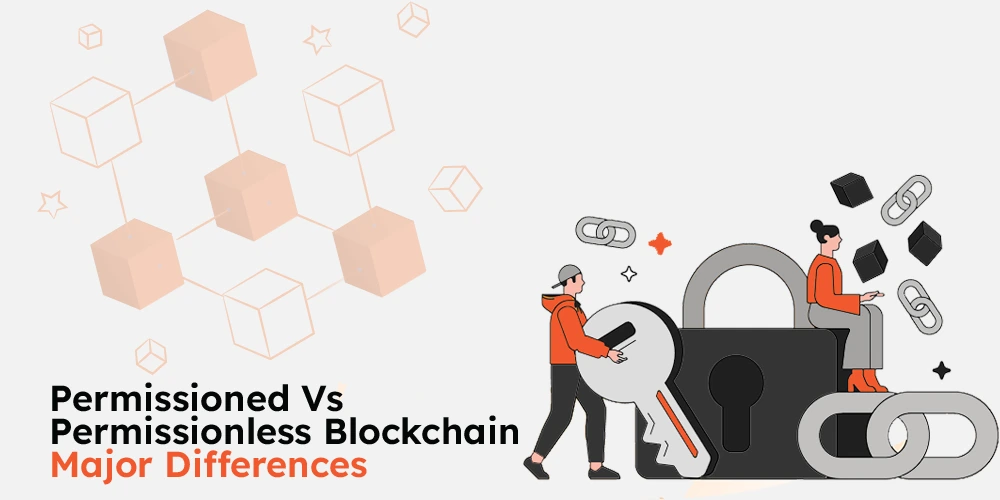Permissioned Vs Permissionless Blockchain: Know The Differences
Updated : June 08, 2023

Blockchain technology has revolutionized various industries by offering transparency, security, and decentralized solutions. When exploring the world of blockchain, you may come across a significant difference guide: permissioned Vs. permissionless blockchain. Smart contract audits are used to secure these contracts.
After performing extensive research, we came up with this detailed guide. In this article, we'll delve into the details of these two approaches, their unique characteristics, and the implications they have in different use cases.
What Is Permission Blockchain?
Permissioned blockchain, also known as private or consortium blockchain. It is a type of blockchain network where access and participation are restricted to a specific group of known entities. Unlike the open nature of permissionless blockchains, permissioned blockchains require permission from a central authority to join and interact with the network.
Key Features
Have a look at the underlying helpful benefits of permissioned blockchain:
-
Access Control
Permissioned blockchains operate with strict access controls, allowing only trusted participants to join the network. This ensures that the blockchain is limited to a specific group or consortium.
-
Identity Verification
Participants in a permissioned blockchain are typically required to undergo identity verification to establish trust within the network. This verification process helps maintain the integrity of transactions and ensures accountability.
-
Transaction Validation
In permissioned blockchains, transaction validation is often performed by pre-selected validators or consensus nodes. These validators are responsible for verifying the accuracy of transactions. It enhances the efficiency and security of the network.
-
Privacy and Confidentiality
Permissioned blockchains prioritize privacy by providing mechanisms to encrypt data and restrict access to sensitive information. This makes them suitable for enterprise applications where data privacy is paramount.
What Is Permissionless Blockchain?
Permissionless blockchain, also known as a public blockchain. It is an open network that allows anyone to join, participate, and contribute to the blockchain without any centralized authority's permission. It operates on a decentralized consensus mechanism where participants collectively validate transactions and maintain the integrity of the network.
Key Features
The following features will help you understand permissionless blockchain technology thoroughly:
-
Decentralization
Permissionless blockchains are built on the principles of decentralization, where no single entity has control over the network. This ensures that power is distributed among participants, enhancing transparency and resilience.
-
Open Access
Permissionless blockchains offer unrestricted access to anyone who wants to participate. Anyone can join the network, create transactions, and contribute to the consensus mechanism.
-
Consensus Mechanism
Permissionless blockchains rely on consensus algorithms, such as Proof-of-Work (PoW) or Proof-of-Stake (PoS), to validate transactions and maintain the integrity of the network. Consensus is achieved through the collective agreement of participants.
-
Transparency
Permissionless blockchains prioritize transparency, allowing anyone to view and verify the entire transaction history. This transparency builds trust among participants and an environment of accountability.
Use Cases and Considerations
Different blockchain development services are available online which provide you with contracts and guide you on their use. But remember, all of them are not reliable. Here is the expert advice on the use cases and considerations of permission and permissionless blockchain:
Permissioned Blockchain Use Cases
-
Enterprise Solutions
Permissioned blockchains are commonly used in enterprise settings, where data privacy, scalability, and restricted access are essential. Industries like finance, supply chain, and healthcare can benefit from the secure nature of permissioned blockchains
-
Consortium Networks
Permissioned blockchains are well-suited for consortium networks, where multiple organizations collaborate and share data securely. By leveraging permissioned blockchains, consortiums can streamline operations, enhance trust, and improve efficiency.
Permissionless Blockchain Use Cases
-
Cryptocurrencies
Permissionless blockchains, like Bitcoin and Ethereum, are widely used for cryptocurrencies and decentralized financial applications. These blockchains allow open participation, peer-to-peer transactions, and public verification.
-
Decentralized Applications (dApps)
Permissionless blockchains provide a platform for developers to build decentralized applications. These dApps leverage the transparent and open nature of permissionless blockchains to create innovative solutions in various domains.
Differences Between Permissioned And Permissionless Blockchain
Here is a quick overview of the major differences between permissioned and permissionless blockchain contracts.
| Factors To Consider | Permissioned Blockchain | Permissionless Blockchain |
|---|---|---|
| Access | Restricted access to known entities | Open access for anyone to join |
| Identity Verification | Participants undergo identity verification | No mandatory identity verification |
| Transaction Validation | Validators or consensus nodes validate transactions | Decentralized consensus mechanism |
| Privacy | Emphasizes privacy and confidentiality | Transparent and public transactions |
| Centralization | Controlled by a central authority or consortium | Decentralized with no single controlling entity |
| Consensus Mechanism | Consensus achieved through a pre-selected group | Consensus achieved through collective agreement |
| Scalability | Typically more scalable due to controlled network size | May face scalability challenges with larger network |
| Use Cases | Enterprise solutions, consortium networks | Cryptocurrencies, decentralized applications (dApps) |
| Trust Model | Trust based on the known and verified participants | Trust based on the network's decentralized architecture |
| Examples | Hyperledger Fabric, Corda | Bitcoin, Ethereum |
Conclusion
Permissioned and permissionless blockchains offer distinct approaches to decentralized technology. While permissioned blockchains prioritize controlled access, privacy, and consortium collaborations, permissionless blockchains emphasize openness, decentralization, and inclusivity. Understanding the characteristics and use cases of each type can help organizations and individuals make informed decisions when adopting blockchain technology.
Take control of your smart contract security - Request a professional Smart Contract Audit today and ensure the solidity of your blockchain projects
Insights

Smart Contract Audit Checklist
Smart contracts are self-executing agreements with the terms of the agreement between buyer and seller being directly written into lines of code ...

How To Audit Smart Contracts?
Smart contracts have become increasingly popular over the years as they provide a more efficient way of executing transactions in a decentralized ...

Smart Contract Vulnerabilities
Smart contracts have revolutionized how we conduct transactions and execute agreements in the digital age. These self-executing programs ...